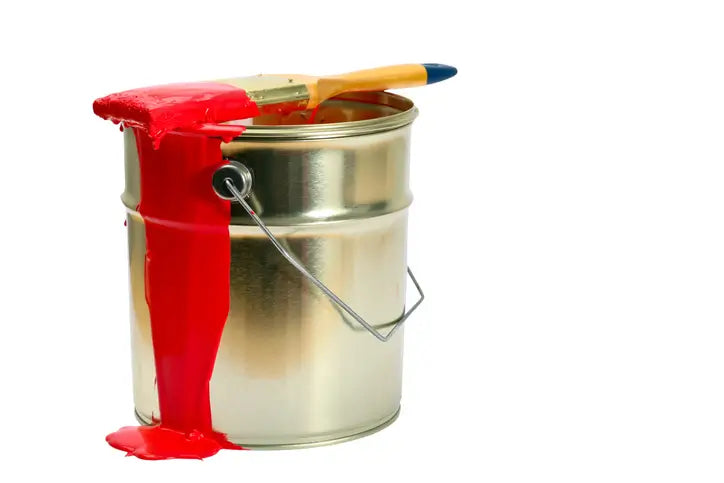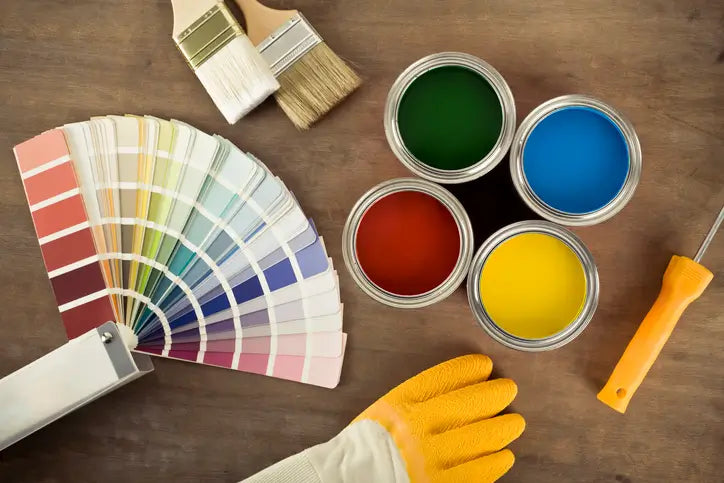A Guide to Paint Ordering Online in East Brookfield, MA
Giving a room a fresh coat of paint is one of the quickest ways to transform your space. A new color can breathe life into a tired room, make a small space feel larger, or add a touch of personal style. Howe Lumber offers paint ordering online in East Brookfield, MA, to make your next project simple and successful. With our full-service approach, we’re here to help you get exactly what you need, from choosing the perfect shade to calculating the right amount.
How to Calculate the Right Amount of Paint

Accurately calculating how much paint you need saves you time and money. It prevents you from making extra trips to the store or ending up with a garage full of half-used paint cans. Here’s how to estimate your needs correctly:
- Measure your space: Start by measuring the length and height of each wall you plan to paint. Multiply these two numbers to get the square footage of each wall, then add them all together for a total.
- Subtract for windows and doors: Measure the doors and windows in the room. Calculate their total square footage and subtract it from the wall’s total square footage. This gives you a more accurate number.
- Consider texture and coats: Rough or textured walls absorb more paint, so you may need a little extra. Most projects also require at least two coats for even coverage, so double your final square footage estimate.
- Don’t forget ceilings: If you’re painting the ceiling, calculate its square footage separately by multiplying the length and width of the room.
- Buy a little extra: It is always a good idea to have some leftover paint for future touch-ups.
Eco-Friendly Paint Options for Your Home
We are proud to offer a range of paints. Many are low-VOC paints. These eco-friendly options are a fantastic choice for anyone concerned about indoor air quality and sustainability. Volatile Organic Compounds (VOCs) are chemicals that can be released into the air as paint dries, and reducing them helps create a healthier living environment. These paints are perfect for families in East Brookfield, MA, especially in homes with children, pets, or individuals with respiratory sensitivities. Choosing a low-VOC paint doesn’t mean you have to compromise on quality or color. You can buy interior and exterior paint that is both beautiful and better for your home.
Paint Finishes
There are several different sorts of finishes for paint products. The finish is the texture, sheen, or shine level that the paint has. Each option has advantages and disadvantages.
- Flat: It has the least shine and a chalky feel. It is not very washable, but it hides wall imperfections well.
- Eggshell: Slightly glossier than flat, it has a texture like an eggshell. It is more washable than flat and less chalky. Popular for interior walls, it also hides imperfections.
- Low lustre: This is primarily used for exterior paints in Benjamin Moore lines. It is not very shiny but glossier than eggshell. It is often used for siding. It sheds rainwater well and doesn’t reflect much sunlight.
- Pearl: This is a popular choice for those wanting a soft shine without the high gloss of semi-gloss or the rougher feel of eggshell. It doesn’t emphasize wall imperfections but doesn’t mask them as well as less glossy paints. It is more washable than eggshell but less than semi-gloss or gloss enamel.
- Semi-gloss: A relatively shiny gloss, often used for interior or exterior trim as an accent. Sheds water well (exterior) and is the most washable of common interior paints. Tends to emphasize wall imperfections due to light reflection.
- Gloss: This is the shiniest gloss level. Traditionally, house paints were often either flat or high gloss and oil-based. Gloss sheds water very well and is durable. It is less commonly chosen today as many find it “too shiny.”
Interior or Exterior Paint
Interior
Interior paints are strictly for use on walls inside the home. They do not have enough substance to fight the elements for very long, and they do not seal the substrate well. With that in mind, interior paints are ideally suited for adding some color to your walls and for sealing drywall or plaster. Their drying time is relatively short, there is a variety of textures, and they are formulated to handle the very different environmental conditions inside your home.
Exterior
Exterior paints are made to protect the outside of your home from rain, snow, and other normal weather events. You might think this makes them perfect for protecting your rooms inside the house as well. After all, if it can stand up to snow and rain, shouldn’t it handle a dog and a three-year-old? In reality, some people actually do this, but we can’t recommend it. The paint takes much longer to dry, and is not designed to withstand the conditions inside a home. Outside is where exterior paints belong.
There are a few that are made to be used in both locations. They are clearly labeled, but be sure to read the label for the manufacturer’s guidelines for application.
Latex-Based or Oil-Based Paint

There are two main basic formulations of paint: latex and oil. Oil paints are the more traditional paints, and have been around for a very long time. Latex paints are a more recent innovation, and one that has been embraced by a vast number of people.
Oil-Based
Oil-based paints, also known as “alkyd” paints, are generally thought of as a more penetrating paint. The oils that the paint uses tend to go deeper into the pores of the surface you paint and bond at a deeper level. The downside is that they can yellow over the years, and in order to clean them up, you need to have paint thinner, turpentine, or other mineral spirits at hand. Just because oils penetrate deeper into the substrate (i.e., into the wood or whatever), it does not mean that an alkyd paint will never peel. Most paints will peel if water gets under them or from weathering through time.
Latex-Based
Latex-based paints bond to the surface and are useful for a number of applications. They provide a good seal at the surface and maintain their color well through time without the yellowing that alkyd paints are known to have. They clean up with water and dry in a relatively short amount of time. These are the main reasons so many people have opted to use latex paints, especially inside their homes.
When to Choose Latex-Based or Oil-Based Paint?
Perhaps the biggest question people have is whether one sort of paint can go over another. For a long time, conventional wisdom said that if you started with oil, stick with oil, and if you started with a latex-based paint, stick with latex. Several years ago, this was changed slightly. Now, the “word on the street” is: Latex paint can go over an oil-based paint. Oil paint should only go over oil paint. Simply put, latex can go over most sorts of paint, but oils should only go over oils. Of course, there are plenty of different opinions about this, and there are many people who will put anything over anything and have no problems. Still, manufacturer recommendations are to put like over like, or latex over both.
A Guide to Picking Colors
Choosing a color is the most straightforward question, and yet it’s sometimes the hardest one to answer. Ultimately, the choice of a paint color is yours. You are buying the paint, and it is for your home, so the choice is in your hands. This section provides paint types and finishes explained to help you make your decision. With that in mind, here are a few helpful hints to help you choose a color.
Colors Darken Over Large Areas
When you choose a color from a small chip, dark colors appear eye-catching and rich. When that same dark purple is spread all over the wall, that same rich color can darken the room considerably. A little bit of color can go a long way when you paint a room. What seems too light in the store may just be perfect in your home. We recommend you order paint samples online to test them in your space.
Touching up Walls
The best way to ensure that you can paint a small spot on the wall without repainting the whole thing is to get extra paint when you do it the first time. Even stock colors can have a little drift in color over time, so that the match is less than perfect. If you keep the excess paint from the job and make sure that it doesn’t dry out, then you will know that you have the same color.
Dark Colors Are Difficult to Cover
If you decide that the dark magenta room is too dark and that it should be simple white, there are a few tips that will serve you well. Use a primer over the dark paint. It will help hide the darker color and save you money in the long run because it will take fewer coats to cover. Be prepared to do at least two topcoats.
Paint Fades Over Time
If you are trying to “touch up” a few rough spots on an older wall, it is unlikely that you will find a paint that matches so well that you won’t notice the difference between the fresh paint and the older paint. The sun fades colors over the years, and touching up walls will show you just how much work the sun has done.
Paint Draws Color out of Patterns
When you choose a color, keep in mind that if there is a subtle color in the fabric of your furniture that matches or resembles the wall color, that hue will be drawn out of the fabric by the eye. This can be a very useful trick in decorating and room design.
Primer Is Indispensable
Priming a new wall, whether it is plastered, drywall, or even raw wood, is a very good idea. Paint manufacturers often will not guarantee their products fully without a coat of primer underneath them. Primer binds to the surface and prepares it so that the paint will bond to it properly.
We Can Match Your Color
We can match most colors using our computerized color-matching system. If you’re trying to match paint you already have, here’s what to look for:
- Old can: This is the easiest way to match paint. The can provides the color, finish, and whether it’s for interior or exterior use.
- Color sample: Bring in a piece of siding, wallpaper, or any sample at least the size of a dime. We can match it by eye or use our color match system to get a precise match.
- Color name: If you know the color name, that’s a great start. Just let us know the finish and whether it’s for interior or exterior use.
- Stain or paint: It can be tricky to distinguish solid stain from paint since both look similar in the can. A stain allows texture to show through, while paint provides a thicker coat that conceals surface irregularities.
Order Your Paint Now
Starting a new paint project is exciting, and our family is here to help yours every step of the way. From design consultation to making sure you have all the right supplies, we provide a relationship-focused service. Stop by our store in East Brookfield or contact us now to get started.
